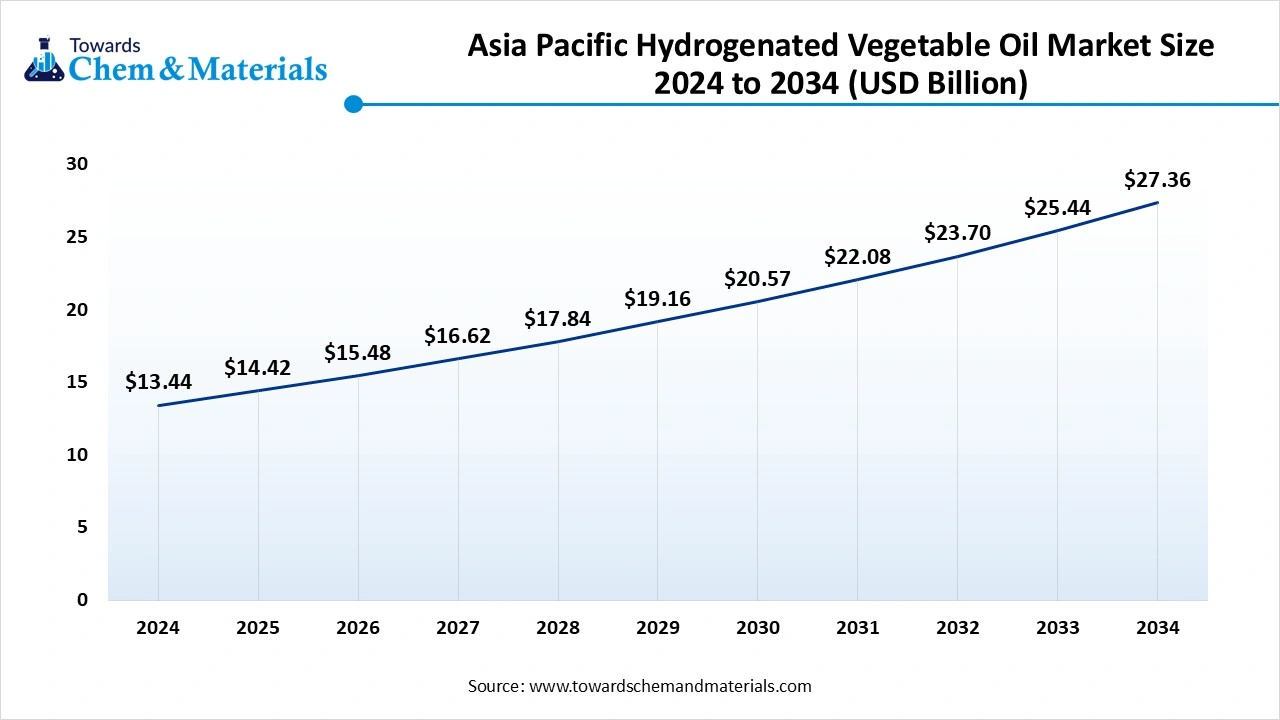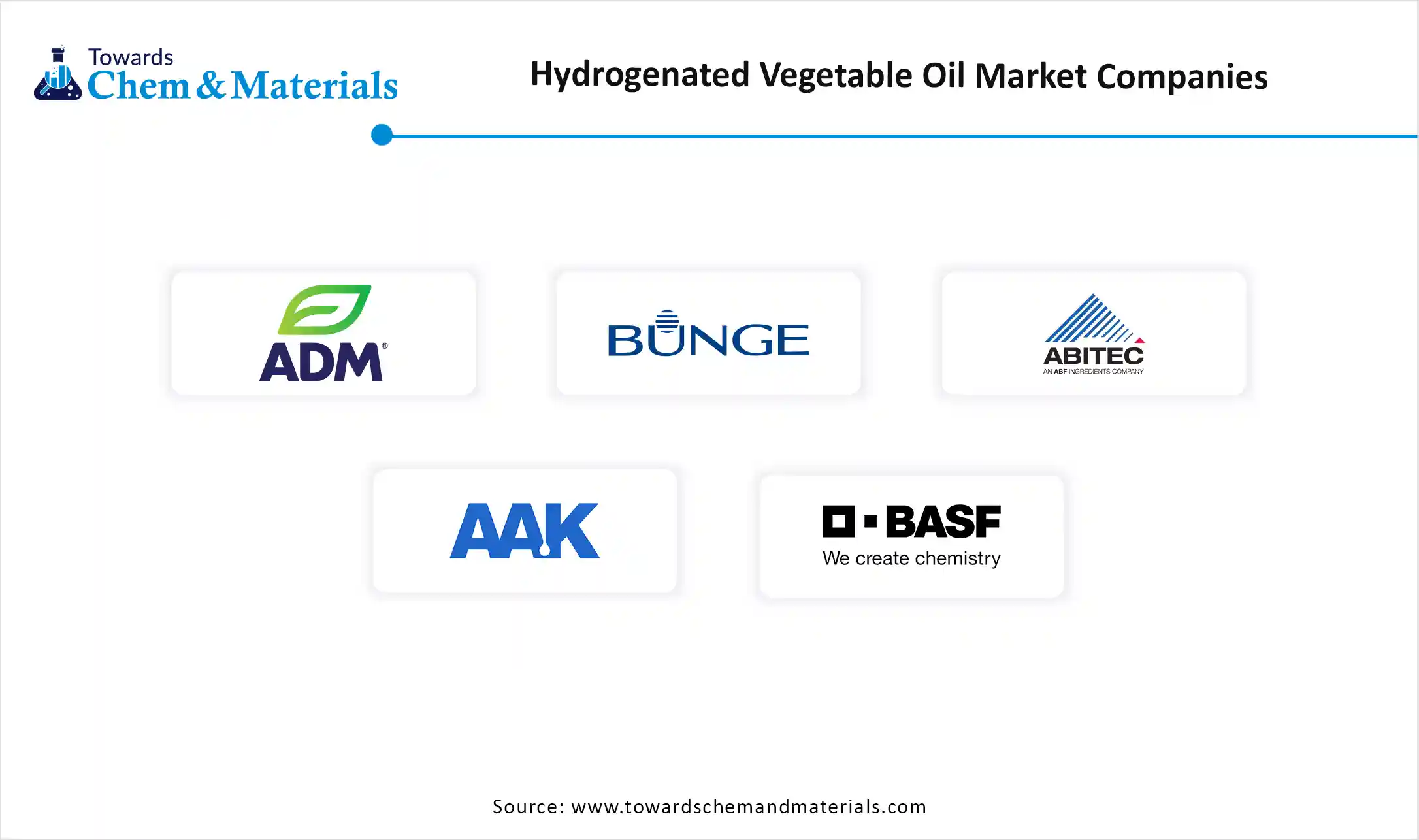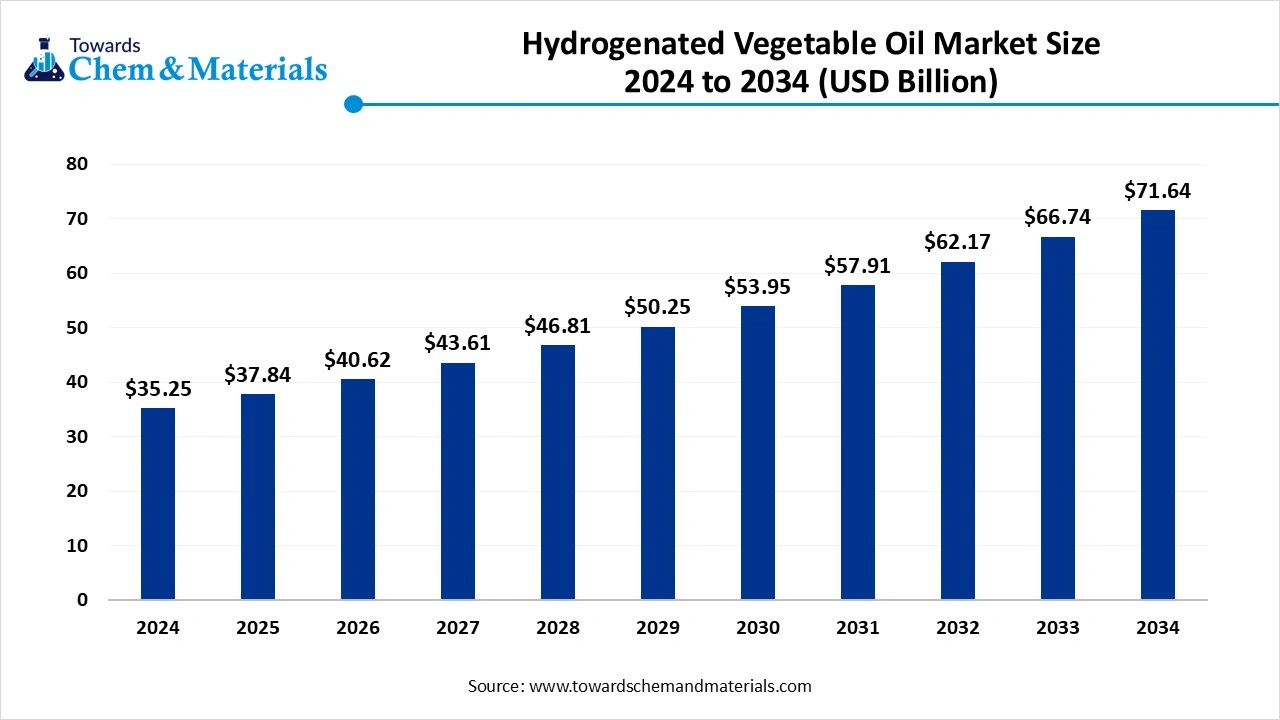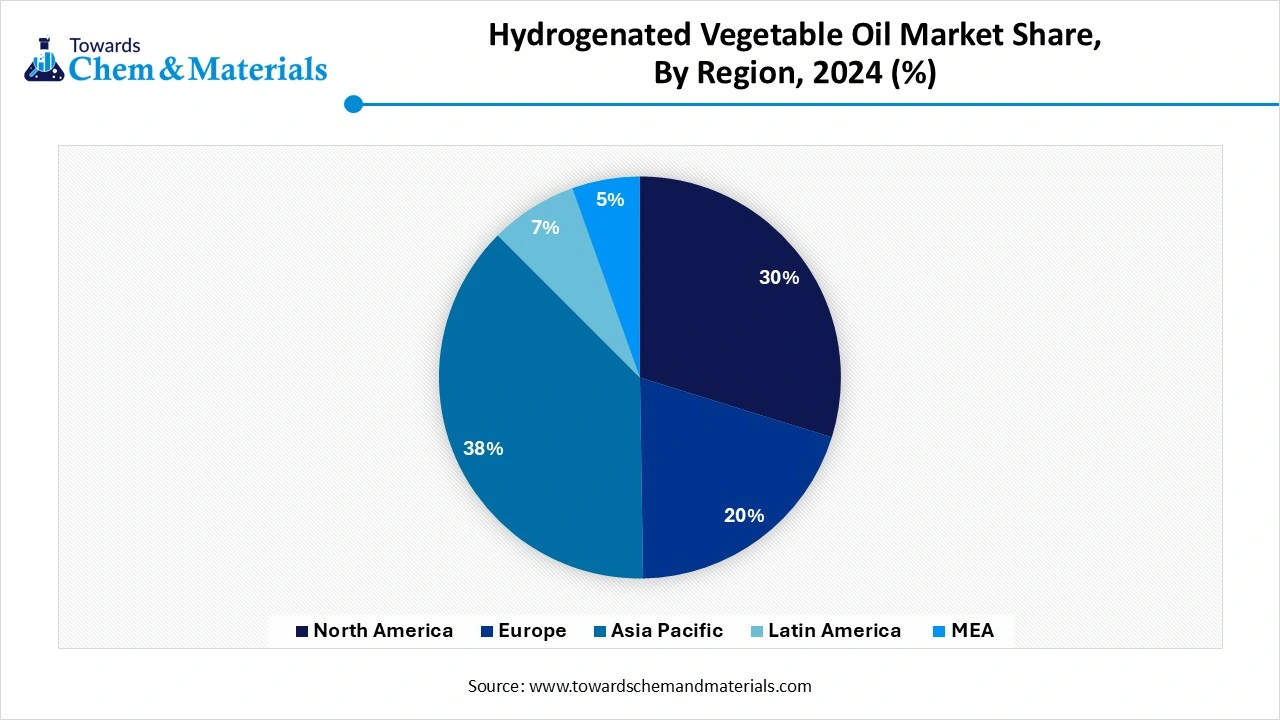Content
Hydrogenated Vegetable Oil Market Outlook Scenario Planning & Strategic Insights for 2034
The global hydrogenated vegetable oil market size accounted for USD 35.25 billion in 2024 and is predicted to increase from USD 37.84 billion in 2025 to approximately USD 71.64 billion by 2034, expanding at a CAGR of 7.35% from 2025 to 2034. The growing demand from the food & beverage industry, increasing consumer preference for natural & sustainable ingredients, and rising demand from industrial applications drive the growth of the market.
Key Takeaways
- Asia Pacific hydrogenated vegetable oil market dominated the global landscape with a revenue share of 38.12% in 2024. due to the well-established food processing industry.
- The North American hydrogenated vegetable oil market is projected to grow at a CAGR of 7.36% during the forecast period. due to the growing expansion of the personal care & cosmetic industry.
- By grade, the unfractionated segment led the market, accounting for the largest revenue share of 46.16% in 2024 due to the growing production of fried foods, margarine, and baked goods.
- By grade, the Fractionated segment is expected to grow fastest with a CAGR of 7.66% from 2025-2034 due to the growing demand for personal care products.
- By end use, the food & beverage segment dominated the market with a revenue share of 54.14% in 2024 due to the growing consumer demand for packaged food.
- By end use, the personal care and cosmetics segment accounted for 22.85% of market revenue in 2024 due to the increasing demand for skincare & haircare products.
The Role of Hydrogenated Vegetable Oil in Food Products & Cosmetics
Hydrogenated vegetable oil (HVO) is a vegetable oil that goes through the hydrogenation process. In this process, hydrogen is added to vegetable oil to enhance its physical properties and convert vegetable oil into a semi-solid form. These oils prevent oxidation and extend the shelf life of the products. It is available in semi-solid or solid form and enhances the texture of the products. Hydrogenated vegetable oil enhances flavor stability and is available at a low cost.
Food products like shortening, fried foods, margarine, baked goods, and snack food uses hydrogenated vegetable oil. It is widely used in personal care products like lip balm, moisturizer, lotions, and creams. The growing expansion of the food & beverage industry increases demand for hydrogenated vegetable oil. The growing production of bio-lubricants increases the adoption of hydrogenated vegetable oil. Factors like the growing demand for renewable fuel sources, increasing spending on personal care & cosmetics products, rising demand from industrial applications, and increasing demand for sustainable products contribute to the overall growth of the hydrogenated vegetable oil market.
- Malaysia exported 1,227 shipments of hydrogenated vegetable oil.
- Indonesia exported 1,150 shipments of hydrogenated vegetable oil. (Source: www.volza.com)
- According to India Export data, Evonik Catalysts India Private Limited is the leading supplier of hydrogenated vegetable oil in India.(Source: www.volza.com)
Growing Energy Sector Propels Growth of the HVO Market
The increasing demand for energy and growing advancements in renewable energy help in the growth of the energy sector. The growing energy sector increases demand for hydrogenated vegetable oil for sustainability. The growing adoption of renewable energy sources like hydropower, solar, and wind increases demand for HVO to lower emissions. HVO is a direct replacement for diesel and reduces emissions in various transportation modes. The government's strong support for cleaner energy sources increases demand for HVO to meet emission targets.
The growing demand for power generation increases the adoption of HVO for energy transition. HVO lowers greenhouse gas emissions and offers cleaner air. The growing government investment in HVO increases adoption in the energy sector. The rapid urbanization and increased demand for energy lead adoption of HVO. The growing energy sector is a key driver for the growth of the hydrogenated vegetable oil market.

Market Trends
-
Growing Demand for Biofuel: The growing demand for biofuel in the aviation and transportation sector increases the adoption of HVO. It is directly used in existing diesel engines and lowers the emission of carbon. The growing transportation demand, like aviation, road, and marine, increases demand for HVO fuel.
-
Technological Advancements: The ongoing technological advancements, like post-treatment processes, advanced pre-treatment of feedstocks, and optimized hydrogenation catalysts, increase product quality and efficiency. The advanced pre-treatment of feedstocks like bleaching, degumming, and deacidification enhances quality and removes impurities in vegetable oil. The innovations, like isomerization, fractionation, plasma-based hydrogenation, and techniques to reduce trans-fat, help the market growth.
-
Growing Consumption of Processed Food: The busy lifestyles and increasing disposable incomes increase the consumption of processed foods. The growing consumption of ready-to-eat and processed food increases demand for HVO to enhance shelf life, product texture, and stability.
Report Scope
| Report Attributes | Details |
| Market Size in 2025 | USD 37.84 Billion |
| Market Size by 2034 | USD 71.64 Billion |
| Growth rate from 2024 to 2025 | CAGR 7.35% |
| Base Year of Estimation | 2024 |
| Forecast Period | 2025 - 2034 |
| Dominant Region | Asia Pacific |
| Segment Covered | By End Use , By Grade, By Region |
| Key Profiled Companies | Bunge, AAK AB, Croda International Plc , Clariant, Archer Daniels Midland, ABITEC, BASF SE, Louis Dreyfus Company, Amandus Kahl GmbH & Co. KG, Evident Ingredients GmbH, Wilmar International Ltd |
Market Opportunity
How Personal Care & Cosmetic Industry Creates Opportunity for the HVO Market?
The growing expansion of the personal care and cosmetic industry increases demand for HVO for various applications. The growing consumer spending on personal care products and the rising demand for various personal care products increases demand for HVO. It has emollient properties and creates a protective barrier on the surface of the skin. The growing consumer focus on natural and sustainable skin & hair care products increases the adoption of HVO. The increasing demand for a longer shelf life of cosmetic and personal care products increases demand for HVO to prevent oxidation. It offers mildness and smooth textures to the skin.
The growing consumer focus on skincare increases demand for HVO to formulate various beauty products. The rising demand for post-makeup and pre-makeup facial oils is fueling demand for HVO due to moisturizing properties. The growing adoption of products like lip balms, moisturizers, lotions, shampoos, serums, and creams increases demand for HVO. The growing expansion of the personal care & cosmetic industry creates an opportunity for the growth of the hydrogenated vegetable oil market.
Market Challenge
Health Concerns Limit Expansion of Hydrogenated Vegetable Oil
Despite several advantages of the hydrogenated vegetable oil, the growing health concerns restrict the market growth. Health risks like type 2 diabetes, heart disease, and stroke increase due to the consumption of hydrogenated vegetable oil. The hydrogenation process creates trans fat that increases LDL cholesterol and reduces HDL cholesterol. The increased fat intake creates a risk of type 2 diabetes and increases inflammation in the body. Food safety authorities implemented several regulations to limit trans fats in various food products. Trans fats affect blood sugar levels and increase the risk of heart disease. The growing health concerns hamper the growth of the hydrogenated vegetable oil market.
Regional Insights
Which Region Dominated the Hydrogenated Vegetable Oil Market in 2024?
Asia Pacific dominated the hydrogenated vegetable oil market in 2024. The Asia Pacific hydrogenated vegetable oil market is expected to increase from USD 14.42 billion in 2025 to USD 27.36 billion by 2034, growing at a CAGR of 7.37% throughout the forecast period from 2025 to 2034. The strong presence of the food processing industry increases demand for hydrogenated vegetable oil for applications like confectionery, packaged snacks, and ready-to-eat meals. The rapid urbanization and growing consumption of processed foods help in the market growth. The presence of abundant feedstock availability, like soybean & palm oil, increases the production of hydrogenated vegetable oil. The increasing adoption of renewable energy requires biofuel is fueling demand for hydrogenated vegetable oil. The strong government support for the use of biofuel increases demand for hydrogenated vegetable oil. The high demand for convenience foods and the growing expansion of the automotive sector drive the overall growth of the market.

What are the Trends for Hydrogenated Vegetable Oil in China?
China is a major contributor to the hydrogenated vegetable oil market. The growing demand for confectionery items, packaged snacks, and ready-to-eat meals increases demand for hydrogenated vegetable oil. The growing focus on sustainable energy sources like renewable energy helps in the market growth. The abundant presence of raw materials like used cooking oil increases the production of hydrogenated vegetable oil. The growing demand for biofuel increases the demand for hydrogenated vegetable oil. The strong government investment in the renewable energy sector and the food processing industry supports the overall growth of the market.
Why is North America Rapidly Growing in the Hydrogenated Vegetable Oil Market?
North America experiences the fastest growth in the market during the forecast period. The extensive government support for the adoption of renewable fuels like hydrogenated vegetable oil helps in the market growth. The growing expansion of the food & beverage industry increases demand for hydrogenated vegetable oil for products like baked goods, margarine, and shortening. The growing demand for convenience meals and processed foods increases demand for hydrogenated vegetable oil. The well-established supply chain & industrial base led to higher production of hydrogenated vegetable oil. The growing expansion of the transportation sector increases demand for hydrogenated vegetable oil. The increasing demand for various personal care & cosmetics products like lip balms & creams drives the overall growth of the market.
United States Hydrogenated Vegetable Oil Market Trends
The United States is a key contributor to the hydrogenated vegetable oil market. The government mandates for renewable diesel fuel increase demand for hydrogenated vegetable oil. The presence of a robust food processing industry helps in the market growth. The growing innovations in the formulations of hydrogenated vegetable oil, like trans-fat-free, are increasing the adoption of hydrogenated vegetable oil. The increasing expansion of the transportation sector is fueling demand for hydrogenated vegetable oil. The growing production of ready-to-eat and packaged foods supports the overall growth of the market.
-
According to United States Export data, PRICESMART INC is the leading supplier of hydrogenated vegetable oil in the United States.(Source: www.volza.com)
Segmental Insights
Grade Insights
Why Unfractionated Segment Held the Largest Share of the Hydrogenated Vegetable Oil Market?
The unfractionated segment led the hydrogenated vegetable oil market in 2024. The increasing expansion of the food industry and the growing production of frying fats, bakery shortenings, and other products increases demand for hydrogenated vegetable oil. Unfractionated oils have good oxidative stability and extend the shelf life of the products. It is a cost-effective solution for industrial applications and retains a complete triglyceride profile. The growing demand for the personal care & cosmetic industry and the pharmaceutical industry drives the overall growth of the market.
The fractionated segment is the fastest growing in the market during the forecast period. The growing expansion of the cosmetic and food industry increases demand for fractioned oils. The increasing demand for premium fat systems and confectionery coatings in the food system helps in the growth of the market. Fractionated oils create fats with customized textural characteristics and melting profiles. They are affordable for the production of fats with certain properties. The increasing demand for personal care products and processed foods supports the overall growth of the market.
End Use Insights
How Food & Beverage Segment Dominated the Hydrogenated Vegetable Oil Market?
The food & beverage segment dominated the hydrogenated vegetable oil market in 2024. The growing expansion of the food & beverage industry in various regions helps in the market growth. The increasing demand for improving shelf life, texture, and consistency of food products increases demand for hydrogenated vegetable oil. The growing consumer focus on stable, convenient, and long-lasting food items increases the adoption of hydrogenated vegetable oil. The food applications like confectionery coatings, shortenings, and frying fats increase demand for hydrogenated vegetable oil. The growing demand for baked goods, processed food, and snacks drives the overall growth of the market.
The personal care & cosmetics segment is experiencing the fastest growth in the market during the forecast period. The growing awareness about hair & skin health increases demand for hydrogenated vegetable oil for personal care products. The growing consumer demand for plant-based and natural products helps in the market growth. Hydrogenated vegetable oil moisturizes and softens the skin. The rising disposable incomes and growing spending on personal care products increase demand for hydrogenated vegetable oil. The growing demand for lip balms, lotions, and creams supports the overall growth of the market.
Recent Developments
- In September 2023, Vantage Data Centers expands rollout of HVO renewable diesel fuel for generators. The aim is to replace conventional fuel and support decarbonization goals. The company develops HVO fuel in Santa Clara, California, and focuses on reducing carbon emissions. The HVO is developed from soybean oil, animal fats, tall oil, and waste cooking oil.(Source: datacenterfrontier)
- In August 2024, Spain’s Cepsa Venture doubling renewable fuel production in Huelva. The plant will produce 500000 tonnes of hydrogenated vegetable oil per year. The new plant gets feedstocks from Apicals' agricultural waste.(Source: ogj)
- In March 2023, AWS switched to HVO fuel in Europe. The company is shifting from diesel to HVO in Sweden for generators. The company derives HVO from renewable sources and aims to improve the sustainability of data centers. The company’s focus is on net-zero carbon emissions by 2040.(Source: datacenterdynamics)
- In October 2023, Bertschi and Dow launched the HVO sustainable transportation solution. Transportation is available from the Netherlands to Italy. The company aims to reduce carbon dioxide emissions and focuses on sustainability. The HVO adoption helps with the 90% emission reduction for the last and first mile.(Source: biofuels-news.com)
- In October 2024, BP launched HVO fuel in Spain for heavy-duty road transport. The fuel is available in Navarre, Madrid, and Valencia at 4 service stations. The company aims to lower carbon dioxide emissions from heavy-duty road transport.(Source: mobilityplaza.org)
Top Companies List

- Bunge
- AAK AB
- Croda International Plc
- Clariant
- Archer Daniels Midland
- ABITEC
- BASF SE
- Louis Dreyfus Company
- Amandus Kahl GmbH & Co. KG
- Evident Ingredients GmbH
- Wilmar International Ltd
Segments Covered
By Grade
- Unfractionated
- Fractionated
- Others
By End Use
- Food & Beverage
- Personal Care & Cosmetics
- Industrial
- Others
By Region
- North America
- U.S.
- Canada
- Europe
- Germany
- UK
- France
- Italy
- Spain
- Sweden
- Denmark
- Norway
- Asia Pacific
- China
- Japan
- India
- South Korea
- Thailand
- Latin America
- Brazil
- Mexico
- Argentina
- Middle East & Africa
- South Africa
- UAE
- Saudi Arabia
- Kuwait


